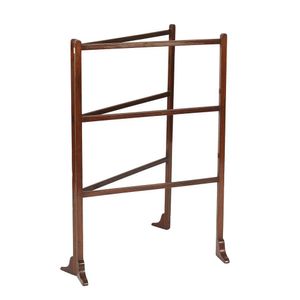Victorian Mahogany Folding Towel Rail
A Victorian mahogany towel rail, a good folding three rung towel rail. England, circa 1880.
You must be a subscriber, and be logged in to view price and dealer details.
Subscribe Now to view actual auction price for this item
When you subscribe, you have the option of setting the currency in which to display prices to $Au, $US, $NZ or Stg.
This item has been sold, and the description, image and price are for reference purposes only.
- Rail - A term used by cabinet makers for the horizontal sections of the frame of an item such as a chair or settee which have a front rail, a back rail and two side rails, and also on a door or carcase, where the rails are joined to the vertical framings.
- Mahogany - Mahogany is a dense, close grained red-coloured timber from the West Indies and Central America. It was first imported into Europe in the the early 18th century and its use continued through the 19th century. It was popular for furniture making because of its strength, the wide boards available, the distinctive grain on some boards, termed flame mahogany and the rich warm colour of the timber when it was polished.. The "flame" was produced where a limb grew out from the trunk of the tree, and this timber was usually sliced into veneers for feature panels on doors, backs and cornices.
Some terms used to describe mahogany relate to the country from which it originally came, such as "Cuban" mahogany, "Honduras" mahogany etc. However unless the wood has been tested the names assigned are more a selling feature, rather than a true indication of the timber's origin. - Circa - A Latin term meaning 'about', often used in the antique trade to give an approximate date for the piece, usually considered to be five years on either side of the circa year. Thus, circa 1900 means the piece was made about 1900, probably between 1895 and 1905. The expression is sometimes abbreviated to c.1900.
- Victorian Period - The Victorian period of furniture and decorative arts design covers the reign of Queen Victoria from 1837 to 1901. There was not one dominant style of furniture in the Victorian period. Designers used and modified many historical styles such as Gothic, Tudor, Elizabethan, English Rococo, Neoclassical and others, although use of some styles, such as English Rococo and Gothic tended to dominate the furniture manufacture of the period.
The Victorian period was preceded by the Regency and William IV periods, and followed by the Edwardian period, named for Edward VII (1841 ? 1910) who was King of the United Kingdom and the British Dominions and Emperor of India for the brief period from 1901 until his death in 1910.
This item has been included into following indexes:
- towel rails 47
Visually similar items

A cedar four-tier open bookshelf, Australian, circa 1840, 127 cm high, 115 cm wide, 24 cm deep.
Sold by
in
for
You can display prices in $Au, $US, $NZ or Stg.

Pair of mahogany folding towel racks, (2), height 90 cm
Sold by
in
for
You can display prices in $Au, $US, $NZ or Stg.

A rectangular brass and cast iron umbrella stand, French, circa 1920, 50 cm high, 37 cm wide, 21 cm deep.
Sold by
in
for
You can display prices in $Au, $US, $NZ or Stg.

A brass and walnut finish three tier occasional table on casters, English circa 1900, 71 cm high, 32 cm square
Sold by
in
for
You can display prices in $Au, $US, $NZ or Stg.
